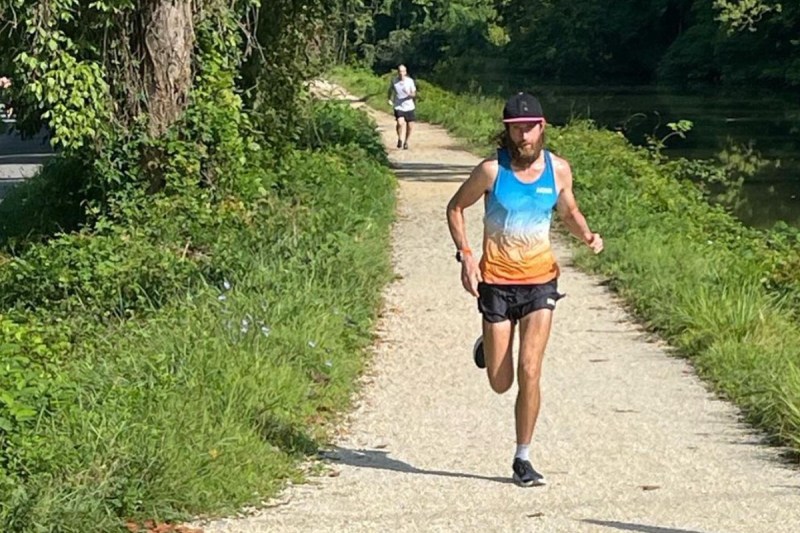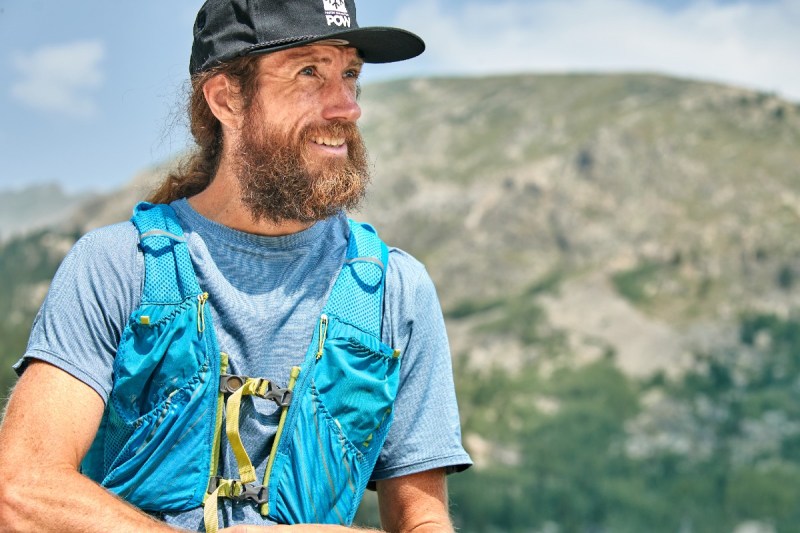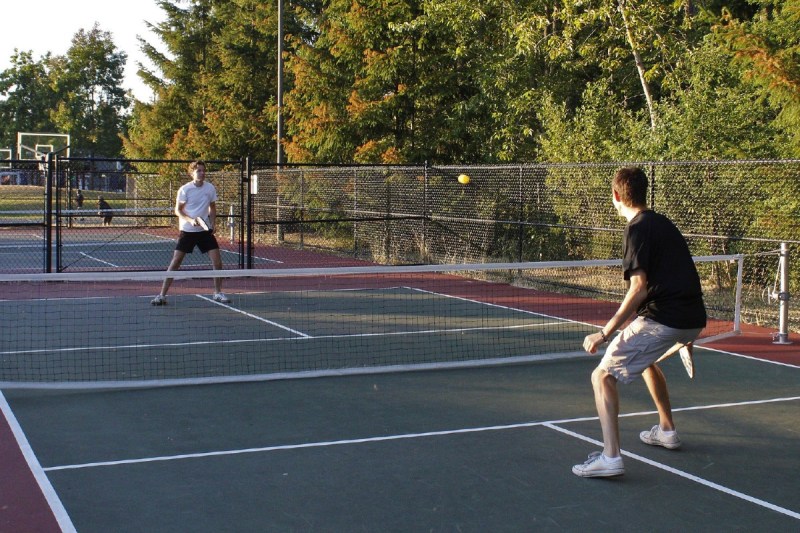Autumn is marathon (and half marathon) season, and we’ve got the running gear and marathon tips that you need straight from one of the world’s most elite runners.
To complete your first or your fiftieth 26.2-mile race, The Manual is here with insider tips from champion ultra-marathoner Mike Wardian. Since 1995, the runner has completed over 300 marathons and ultra-marathons, set Guinness World Records, run seven marathons on seven continents in seven straight days, and, this summer, completed the “Forrest Gump,” jogging across the continental United States in 61 days.

“This was actually a long, long time coming,” Wardian said in a chat with The Manual. “I had seen Forrest Gump all those years ago and was like, ‘Man, that’s crazy cool.’ Once I started running, that (was) just such a far-off dream.”
This just goes to show: you never know what’s going to be coming down the road next. All you can do is make that next step and see what happens. So fill up those water bottles and strap up your laces. It’s time for a fun, focused run of tips on how to train for a marathon from a long-distance superhero.
Gear is good… to a point
When people begin a new activity, there’s a natural desire to want to run out and buy new stuff. And why not? It’s fun to get new gear. This habit can get expensive, quick, and to be honest, all that’s really needed to train are a quality pair of running shoes and wicking clothing. As you get further into the sport and farther away with your runs, though, you’re going to want to begin to upgrade your running setup.
“A hydration vest is a really good investment as people get into this a little bit more,” Wardian said.

The ultra-marathoner often will use a four-liter Pinnacle vest.
“It’s small but nimble,” Wardian said. “You can have a soft flask in one pocket, and your phone, money, and AirPods in the other. I’ll use it when I run around the neighborhood. I can even put poop bags in there and a ball for when I run with the dogs.”
Wardian used a Pinnacle running belt on his cross-country trek, which allowed for Bluetooth headphones, mobile phone, money, and Garmin tracker storage. This also works if you’d rather go shirtless than sport a bulky vest. In this case, there are water bottles it’s designed to hold while you’re running.
“It’s more of a North American thing, but handheld water bottles are quite easy to use. And it’s something that allows you a lot, a lot of flexibility,” Wardian said.
Wardian is sponsored by Nathan Sports and vouches for carrying a number of its water bottles, which range from pull-cap, quick-shot flasks, which provide runners “just enough water” to large, one-liter hydration bottles.
Follow the marathon training schedule
The marathon training schedule is pretty typical across the sport: four days of running during the week followed by a long weekend run, with cross-training mixed in on off days and tempo runs (sustained fast running shifts that help your body push its high-end endurance). Since Wardian began training in 1995, he has followed a similar regimen.

“The first time I ran, I just wanted to qualify for Boston,” Wardian said. “Since then, it’s gotten a lot more refined, but a lot of the processes are the same as what you’ll traditionally see — easy runs and then a longer run along with tempo runs and hill workouts.”
The goal of training is to extend your mileage and time. Progress is as simple as repetition and constant, gradual increases in distance and speed.
Strength and cross-train
Training for a marathon takes a lot of time and dedication. It’s not an easy ask to find the space or the motivation to get to the gym, but it can make a big difference.
“What’s been really helpful for me is adding in strength training and mobility stuff in the last five or six years,” Wardian said. “That’s really made a big difference, especially as I’ve aged.”
Your goal with strength training for a long race is not so different as it would be with a regular gym program. People want to increase muscular and tendon power, which, in turn, can help make running easier, thus decreasing time and upping running rates.

Cross-training is another preparation aspect that can get lost in the long shuffle toward a marathon. What cross-training means is working across disciplines. Biking, swimming,
“I picked up pickleball during 2021, and now I want to try to go pro,” Wardian said. “I went from not even knowing what the sport is to knowing all the top players and spending four or five hours a day working on my game.”
Besides an additional outlet to running, pickleball will help Wardian’s quickness and high-speed stamina while feeding his competitive fire. There’s no need for you to go pro, but mixing alternate sports into training is key to auxiliary development.
Play games
Competition not only helps human beings develop healthier bodies, but floods the brain with calming, euphoric hormones and allows for better oxygen flow, which encourages calmer, sharper minds. It stands to reason that the opposite is going to be true — training the brain to help the physical realm. In order to sharpen his run tactics, Wardian leans on an ancient board game.
“I ran like it would be a very long classical game of chess,” Wardian said. “It’s a three- to four-hour game. There’s all different kinds of time controls that dictate the different ways that you play. I thought of my run across the country very strategically.”

The ultramarathoner wanted to average 50 miles a day in 12 hours. In order to have the energy to complete that, Wardian consumed five- to seven-thousand daily calories. This would keep him going without burning himself out. He honed this attack with internationally renowned trainer Karl Meltzer and his dad, Dick Wardian, who followed Wardian’s progress each day in an RV. There was cold weather, warm weather, and rainy weather gear on hand. There were first aid supplies, ice, and everything else that could cut down on possible accidents.
“If something’s gonna go wrong, or can go wrong, it will go wrong. I just wanted to limit the chances of things going so wrong that they derailed what I wanted to do,” Wardian said.
Along the way, the RV got stuck in the mud for half day, Wardian ‘popped’ a hamstring dodging a car, and there were a few angry drivers that weren’t happy to have a runner pounding pavement with them. Because Wardian approached the task with a similar approach as he did to chess, he was able to overcome those obstacles.
Stay healthy and watch your back
Danger is one of the things that you don’t always associate with running. With cars running behind and in front, however, there’s a good chance that some people just aren’t going to see a random runner on the road. Make sure to wear something glossy and/or light reflective. Wardian also reminds us that sharing the street can be a foreign concept to some.
“In rural places, where they’re not used to seeing people doing this, sometimes they don’t know how to deal with it,” Wardian said. “I had a half-eaten hamburger thrown at me. People screamed at me, intentionally came over the white line.”

He had to be aware at all times, and even sometimes, that wasn’t enough, such as when a semi truck’s rearview mirror whooshed over his head.
“I’ve been in some pretty tight situations — on some mountain tops in bad weather, bad visibility, holed up in a cave with a space blanket and wondering how this is going to end,” Wardian said. “Feeling the draft and seeing the mirror go over the top of my head, that was scarier.”
Dodging
“The first couple of days were really scary. I was jumping off the road the entire time. By the third day, I was like, ‘There’s no way I can go 3,200 miles east to west and 1,000 miles north and south, jumping off the road,’ ” Wardian said.
If you’re not crossing the country from west to east, it can be easier to avoid busy byways, but if you’re putting in 25 to 100 miles running a week, you’re going to have to allot sections of asphalt to drivers. Staying aware of your surroundings should alleviate most potentially dangerous situations.
While drivers aren’t something you have to worry about if you’re participating in a marathon, they are something you need to be aware of as you train.
Encourage and connect with others
Where those frightening interactions were memorable, they were also rare. Wardian found mostly commiserate souls on the road.
“For every mean person, there’d be eight who would stop to offer help and offer water.”
Putting oneself in new, sometimes uncomfortable situations, the best and worst in people often shines through. There is little chance that Wardian could have accomplished this humongous personal challenge without the help of others.
“I spent 80 to 85% of the days by myself. The days when I had people made things so much better,” Wardian said.

This included his wife and two boys stopping by to visit. There were runners who would join Wardian for a couple of hours, sometimes full days, even friends who returned for multiple legs of the journey.
“My whole point of doing this was to see the country, to do good for other people, and to connect with the running community,” Wardian said. “It was just awesome to have a chance to connect with people and learn about them, and be a part of their journey as they’re part of my journey.”
Personal and communal rewards lie at the end of the trek, but it can take months to get there. It doesn’t matter if it’s your first or your fiftieth marathon, or if it’s a 10K or a 50K you’re training for, take some time to link up with others, and share the goal.



